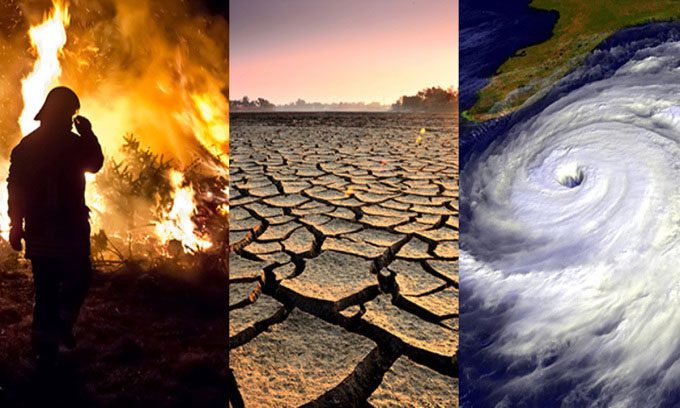Experts predict alarming death tolls related to climate change based on several laws, including the “1,000-ton rule.”
A new assessment published in the journal Energies, based on 180 articles on mortality rates due to climate change, presents a concerning figure, Science Alert reported on August 30. In the coming century, a billion people, or even more, could lose their lives due to climate disasters.
Like most predictions, this forecast is based on several assumptions and rules, including the “1,000-ton rule.” According to this rule, for every 1,000 tons of carbon that humanity burns, one person in the future could be indirectly sentenced to death.

In the future, global climate change could lead to more frequent wildfires, longer droughts, and stronger storms. (Photo: Mellimage/Shutterstock/Montree Hanlue/NASA)
If the world reaches temperatures more than 2 degrees Celsius above pre-industrial average global temperatures—a scenario likely to occur in the coming decades—many lives will be lost. Currently, for every 0.1 degrees Celsius increase, the world could face about 100 million deaths.
Calculating human mortality due to climate change is extremely difficult, even in modern times. According to the United Nations, environmental factors claim about 13 million lives each year, but it remains unclear how many of these are directly or indirectly affected by climate change. Some experts estimate that abnormal temperatures kill around 5 million people annually, while others provide lower estimates.
One reason for the difficulty in these calculations is the diverse impact of climate change. Crop failures, droughts, floods, extreme weather, wildfires, and rising sea levels can all affect human lives in complex ways.
Predicting the number of future deaths from these climate disasters is an incredibly challenging task, but energy expert Joshua Pearce from Western University (Canada) and Richard Parncutt from the University of Graz (Austria), the two authors of the review, believe it is worth investigating. According to the two experts, measuring emissions in human-related aspects makes the data more accessible to the public while emphasizing the urgent need for action.
Pearce and Parncutt applied the 1,000-ton rule to the Adani Carmichael coal mine in Australia, which is expected to become the largest coal mine ever. They argued that burning the entire reserves of this coal mine could lead to approximately 3 million premature deaths in the future.
Technically, the 1,000-ton rule does not account for climate feedback loops (the influence of one climate process on another, which then affects the original process in return). This could mean that in the future, the environmental consequences of carbon emissions may occur even more rapidly and severely. The 1,000-ton rule is not a specific number but rather a range, indicating about 0.1 – 10 deaths per 1,000 tons of carbon burned. This implies that a worse-case scenario could happen.




















































